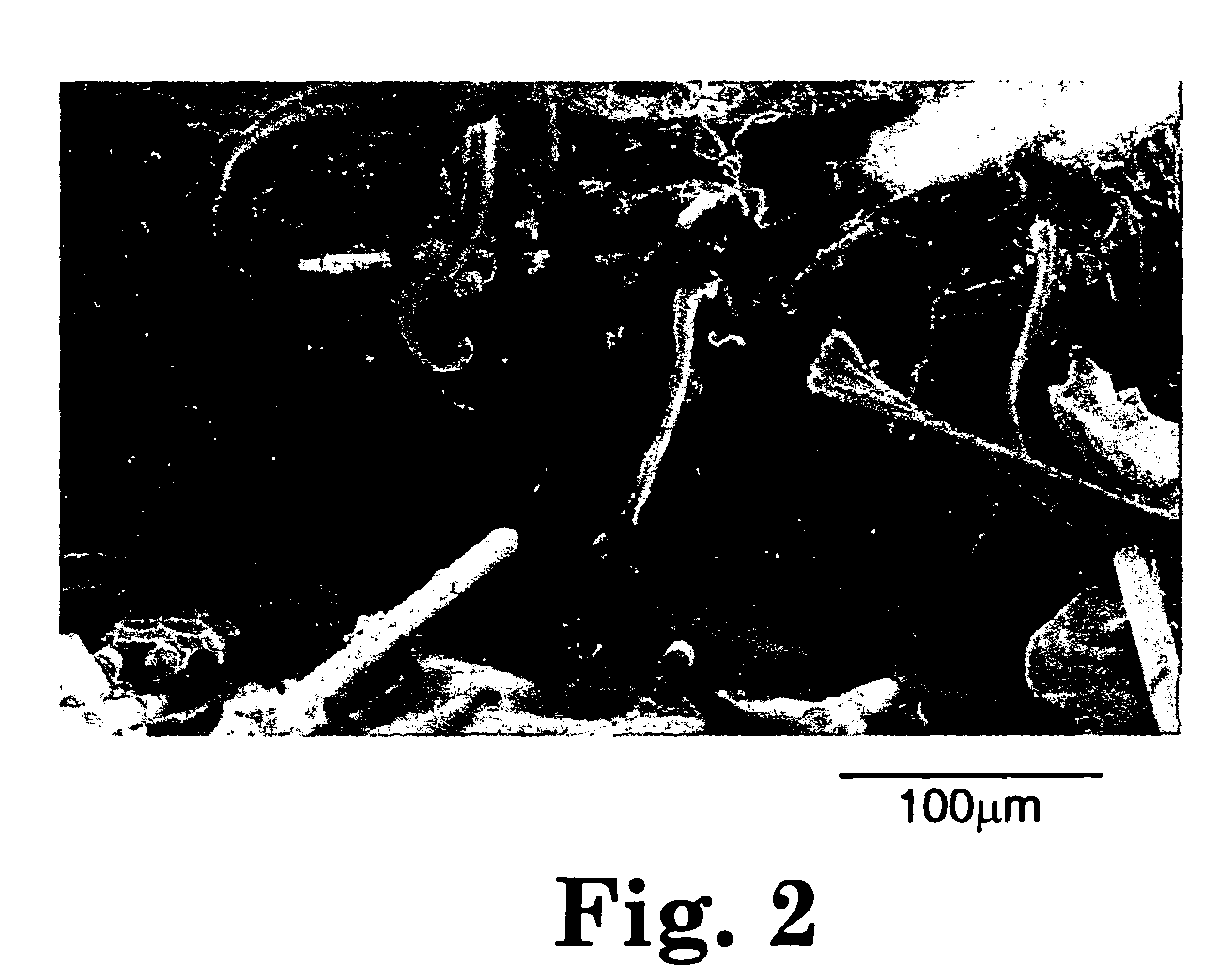Composite articles reinforced with highly oriented microfibers
a technology of high-oriented microfibers and composite articles, applied in the field of composite materials, can solve the problems of composite articles that are unsuitable for marine applications, many materials, and relatively brittle matrix, and achieve the effect of increasing the toughness of composite materials and adding strength and stiffness to elastomeric matrix materials
- Summary
- Abstract
- Description
- Claims
- Application Information
AI Technical Summary
Benefits of technology
Problems solved by technology
Method used
Image
Examples
examples 1 – 2 (
EXAMPLES 1–2 (REINFORCED ELASTOMERIC POLYPROPYLENE) AND COMPARATIVE EXAMPLE C1
[0128]Samples of semi-syndiotactic polypropylene were pressed into films ranging in thickness from 50.8 to 501 microns, using a Model C Carver Laboratory Press (Fred Carver Inc., Wabash, Ind.) with a 15.2×15.2 cm heated platten. The applied load was 6.895 Mpa, and the platten temperature either 121° C. or 177° C.
[0129]A microfibrillated web made by microfibrillating highly oriented polypropylene as described in Example 1 of U.S. Pat. No. 6,110,588 was sandwiched between two semi-syndiotactic polypropylene films having a thickness of 0.18 to 0.25 mm and pressed at 6.895 Mpa with the platen temperature at 121° C. to a thickness of 0.30 to 0.38 mm. Visual inspection of the resulting reinforced syndiotactic polypropyene composite sheet revealed that complete wetting of the microfiber bundles was not achieved. Samples having a width of 0.635 cm and a length of about 7.6 cm were cut from the composite sheet, som...
example 9 (
THERMOSET EPOXY COATED MICROFIBER ARTICLES) AND COMPARATIVE EXAMPLE C4
[0143]Samples of microfibrillated web employed in Example 1 were coated with a solution of ERL 4221™ epoxy with 2% triarylsulfonium hexafluoroantimonate dissolved therein. The samples were allowed to drain for 0.5 hour and were subsequently cured by exposure on each side with three passes at 0.3 m / minute under a Fusion Systems D bulb. The samples were allowed to sit for one week prior to testing. Control samples of cured epoxy sheets were made by pouring the ERL 4221™ epoxy with 2% triarylsulfonium hexafluoroantimonate into a silicon lined polyester mold, and then curing initially with 4 passes at 1.37 m / minute under a 300 W Fusion Systems D Bulb. The resulting initially cured control samples were then covered with a glass plate and exposed to the following cure cycle: 15 minutes @ 50°, 75°, 100°, 120° and 140° C.
[0144]The thermoset epoxy coated microfiber samples, the cured epoxy control samples, and microfibrill...
example 10 (
MICROFIBER REINFORCED MOISTURE CURED URETHANE COMPOSITE AND CASTING ARTICLE)
[0146]A moisture curable urethane resin was prepared by mixing together under dry nitrogen the following components and stirring at about 60° C. for about one hour, all amounts shown in parts by weight:
[0147]
Isonate 2143L ™ (polyisocyanate from Dow Chemical55.18Co., Midland, MI) Benzoyl Chloride0.05ARCOL PPG 725 ™ (725 molecular weight polypropylene42.36glycol from ARCO Chemical Co., Newtown Square, PA)4-(2-(1-methyl-2-(4-morpholinyl)ethoxy)ethyl)morpholine1.952,6-di(t-butyl)-4-methylphenol0.48DC Antifoam 1400 ™ (Dow Corning Corp., Greensboro, NC)0.18
[0148]Microfibrillated polypropylene webs made essentially as described in Example 1, but 95% microfibrillated, dimensioned 12 cm wide by 0.5 m long, were impregnated with the designated amount of the moisture curable urethane resin in a dry air room, rolled onto polyethylene cores, and heat sealed in aluminum foil lined pouches. After 24 hours, one of the rolle...
PUM
| Property | Measurement | Unit |
|---|---|---|
| effective average diameter | aaaaa | aaaaa |
| surface area | aaaaa | aaaaa |
| tensile strength | aaaaa | aaaaa |
Abstract
Description
Claims
Application Information
 Login to View More
Login to View More - R&D
- Intellectual Property
- Life Sciences
- Materials
- Tech Scout
- Unparalleled Data Quality
- Higher Quality Content
- 60% Fewer Hallucinations
Browse by: Latest US Patents, China's latest patents, Technical Efficacy Thesaurus, Application Domain, Technology Topic, Popular Technical Reports.
© 2025 PatSnap. All rights reserved.Legal|Privacy policy|Modern Slavery Act Transparency Statement|Sitemap|About US| Contact US: help@patsnap.com



